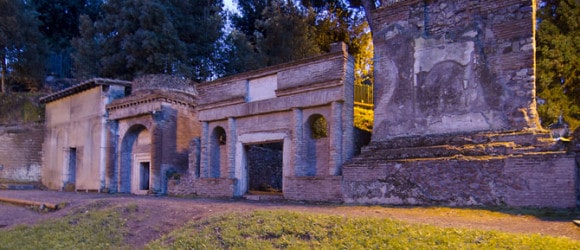The City of the Dead in a City of the Dead
- At May 13, 2014
- By mausoleum
- In Doug Keister's Blog
0

Pompeii’s Mausoleums Provide the First Glimpse of the City
Mausoleums make great time capsules, mirroring the styles and traditions of the cultures that create them. Nowhere is that more evident than Pompeii, a city of the dead.
The citizens of Pompeii had plenty of warning signs they were sitting on the edge of the time bomb Mt. Vesuvius. In 62 C.E., a small earthquake rattled the town. Seventeen years later, in 79 C.E., fissures opened and steam poured out of the cracks. A few days later, pent-up gasses exploded, raining down rock and ash all over the city and prompting over 18,000 of Pompeii’s citizens to flee. Fifteen hundred people were left behind — those who either chose to stay or couldn’t escape fast enough. Staying proved to be a fatal error. Every one of the 1500 perished.
The 79 C.E. eruption of Mt. Vesuvius buried Pompeii in a thick layer of volcanic ash (tephra) approximately 75 feet deep and put a timestamp on what life was like in a small Roman town in the autumn of 79. Pompeii became an architectural and historical treasure trove.
The town of Pompeii was almost lost to history until 1748, when a Spanish engineer Rocque Joaquin de Alcubierre rediscovered the site (there were also very minor excavations at Pompeii as early as 1599). However, by the end of the 18th century, serious (and ongoing) excavations began.
The first thing most visitors experience when entering Pompeii are the mausoleums. Why? Since 449 B.C.E. the Roman Republic (later the Roman Empire) was governed by a code of laws known as The Law of Twelve Tables. A statute in Table X stipulated that “no burial or cremation of a corpse shall take place in a city.” Thus, the roads leading into Pompeii are lined with mausoleums.
Like the buildings within Pompeii, the mausoleums surrounding the city are constructed in a variety of styles. Lining the approaches to Pompeii are delicate temples, curving bench-like exedras, and imposing mausoleums embellished with altars, frescos, portrait sculptures, and intricate carvings. Indeed, after the excavations began receiving worldwide attention in the 19th century, the design of Pompeii’s houses of the dead influenced funerary style and ornamentation all over the Western world.
Interestingly, mausoleums in Pompeii reached the height of their popularity after cremation became the most frequent type of burial. The reasoning is simple: before embalming, bodies that could have been entombed in a mausoleum would have rapidly decomposed, emitting a pungent odor. So instead of being entombed in a mausoleum, bodies were buried in the ground. After cremation became the norm, wealthy Pompeians built mausoleums as close to the city limits as the law allowed and entombed the deceased in urns they placed inside. Just like any kind of real estate, the wealthy wanted their mausoleums as close to the city limits as possible.
Certainly there were bodies entombed in some of the mausoleums, but cremation and the subsequent placement of the deceased ashes in an urn was by far the more common method.Visitors will find the most well documented and excavated mausoleums on the road from Pompeii going northwest to Herculaneum, creating a city of the dead within a city of the dead.
Text and copy © Douglas Keister Visit Doug’s Author Page
